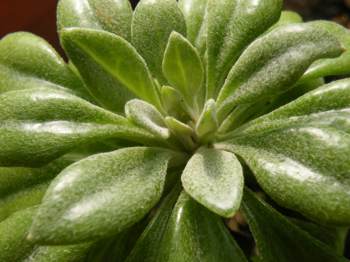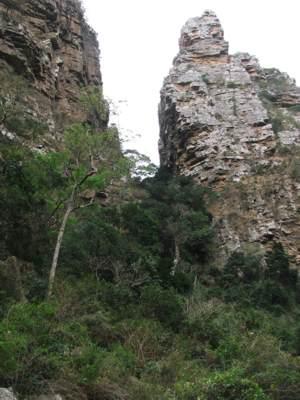Caputia oribiensis
Caputia oribiensis (Van Jaarsv.) Manning (= Senecio oribiensis Van Jaarsv.)
Family: Asteraceae
Common names: Oribi Gorge caputia (Eng.); Oribi-tontelbos (Afr.)
Introduction
Caputia oribiensis is an ascending, sparsely branched, drought tolerant, succulent shrublet, belonging to the daisy family (Asteraceae), with showy, spreading leaves in a central rosette and ascending, striking yellow flowers. It is ideal for the waterwise garden.

Description
Description
This is a spreading, ascending to decumbent, sparsely branched subshrub with fibrous roots and branches up to 500 mm long. Branches are rounded (terete), succulent, 6-10 mm in diameter, greyish, with scars left by older leaves (torrulose). Younger branches are at first covered with fine hairs, almost like a cobweb, becoming smooth later.

Leaves are 45-80 × 16-23 mm, succulent, flat almost like a narrow spoon, spirally arranged and densely crowded in apical rosettes up to 100-160 mm in diameter. They are ascending at first becoming spreading and drooping lower down, each with a petiole 12-18 mm long tapering but widening again at base, 2-3 mm in diameter; the leaf margin entire occasionally bearing a shallow lobe in the centre, the base wedge-shaped, the tip blunt.
Inflorescences are branched and round-topped at the ends of the branches, bearing 5-12 heads; each head nodding at first and then becoming ascending. Flower heads are bell-shaped, and about ±9 mm in diameter. Ray florets are bright yellow; and the disc florets tubular.
Conservation Status
Status
Although Caputia oribiensis is a rare species, and is assessed as Critically Rare on the Red List of South African Plants, it is protected by its inaccessible habitat, its population is stable and it is not currently threatened. Plants are well established in cultivation (ex situ conservation) and grown by succulent plant growers enthusiasts.
Distribution and habitat
Distribution description
Caputia oribiensis is only known from Oribi Gorge in KwaZulu-Natal, growing on sandstone ledges of sheer cliffs. The vegetation consists of Eastern Valley Bushveld (Sub-escarpment savanna bioregion) (Mucina et al. 2006).
This species is unarmed but finds it protection from the sheer cliffs. Although rain falls mainly in summer and winter and ranges from 500-800 mm per annum, there is a tendency toward winter dryness. The average annual daily maximum temperature is about 23°C and the average daily minimum about 12°C. Caputia oribiensis grows at an altitude of 100-600 m on soils drived from Table Mountain Sandstone. The soil is sandy, mineral poor and acidic. The plants grow in full sun or light shade, the leaves tend to grow crowded in rosettes at branch ends. Leaves are is covered with dense silvery hairs that reflect the sun, an adaptation to the dry condition. Near the Oribi Gorge Hotel, the plants were growing in association with the following species species: Caputia medley-woodii, Gasteria croucheri, Aloe pluridens, Bulbine latifolia, species of Delosperma, Crassula cultrata, C. perforata and C. perfoliata, Cotyledon orbiculata and Albuca longibracteata. Larger trees and shrubs in the habitat include Cussonia spicata, Cryptocarya wyliei, Portulacaria afra and Osteospermum moniliferum.

Derivation of name and historical aspects
History
The generic name Caputia was established by Bertil Nordenstam and Pieter Pelser in 2012, the name is an allusion to its geographical origin, the Cape of Good Hope (Nordenstam & Pelser 2012). The plant was first named Senecio oribiensis, by the author in 2011, from plants collected at Oribi Gorge (Van Jaarsveld 2010), however, it was transferred to the newly created genus Caputia by John Manning in 2013 (Manning 2013).
Ecology
Ecology
Caputia oribiensis flowers during midwinter (June and July) and it is pollinated by insects. The seeds are dispersed by wind. Seeds ripen during spring and summer and coinciding with the summer growing season.
Uses
Use
Apart from its horticultural use, the plants have no recorded economic benefits.

Growing Caputia oribiensis
Grow
Caputia oribiensis grows fairly fast, forming a branched, attractive succulent shrublet habit. It is a charming species best grown in containers or in bushveld gardens (Van Jaarsveld 2010). It also thrives in Mediterranean gardens in Europe and California (USA) where frost is not severe. This species is easily propagated by cuttings. It prefers full sun, however, when grown in slightly shady conditions the leaves tend to be larger and greener. The soil should be well drained and the plants thrive in a rockery or on a sunny slope. Caputia oribiensis also makes a wonderful container subject. Plants should reach flowering size within a season.
Caputia oribiensis plants are is easily propagated from stem cuttings. It is best to allow the stem cuttings to form a heel by placing it them on a dry window sill for one to three weeks before planting. Root cuttings in a small container in a well-drained medium. Grow in sand or gravel and place in a warm sunny position. This can be done throughout the year but spring or summer is best, when plants should rapidly root within 4 weeks. Once rooted, they can be planted out in larger containers and kept until ready for planting in a sunny well-d rained spot in the the garden. Feed plants with an organic fertiliser (compost or any other liquid fertiliser). Although Caputia oribiensis can be watered at any time of the year, watering should be reduced during in winter.
References
- Mucina, L. & Rutherford, M.C. (eds ). 2006. The vegetation of South Africa, Lesotho and Swaziland. Strelitzia 19. South African National Biodiversity Institute, Pretoria.
- Nordenstam, B.E. & Pelser P .B. 2012. Caputia , a new genus to accommodate four succulent South African Senecioneae (Compositae) species. Compositae Newsletter 5 0: 56 - 69.
- Raimondo, D., Von Stad i e n, L ., Foden, W., Victor, J.E., Helme, N.A., Turner, R .C ., Kamundi, D.A. , & Manyama, P.A. (eds. ). 2009. Red List of South African plants 2009. Strelitzia 25. South African Na tional Biodiversity Institute, Pretoria.
- Rowley, G.D. 1994. Succulent Compositae . Strawberry Press, Mill Valley, California.
- Van Jaarsveld, E.J. 2010. Water Wise Gardening . Struik, Cape Town.
- Van Jaarsveld, E.J. 2011. Senecio oribiensis (Asteraceae), a new cliff-dwelling species from Oribi Gorge, KwaZulu-Natal, South Africa. Aloe 4 8, 4 : 78 - 81.
Credits
Ernst van Jaarsveld
Kirstenbosch National Botanical Garden
August 2014
Plant Attributes:
Plant Type: Shrub, Succulent
SA Distribution: KwaZulu-Natal
Soil type: Sandy, Loam
Flowering season: Late Summer, Autumn
PH: Acid, Alkaline, Neutral
Flower colour: Yellow
Aspect: Full Sun
Gardening skill: Easy
Special Features:
Horticultural zones









Rate this article
Article well written and informative
Rate this plant
Is this an interesting plant?
Login to add your Comment
Back to topNot registered yet? Click here to register.